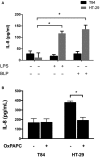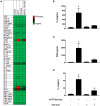TLR4 Participates in the Inflammatory Response Induced by the AAF/II Fimbriae From Enteroaggregative Escherichia coli on Intestinal Epithelial Cells
- PMID: 31131263
- PMCID: PMC6509964
- DOI: 10.3389/fcimb.2019.00143
TLR4 Participates in the Inflammatory Response Induced by the AAF/II Fimbriae From Enteroaggregative Escherichia coli on Intestinal Epithelial Cells
Abstract
Enteroaggregative Escherichia coli (EAEC) infections are one of the most frequent causes of persistent diarrhea in children, immunocompromised patients and travelers worldwide. The most prominent colonization factors of EAEC are aggregative adherence fimbriae (AAF). EAEC prototypical strain 042 harbors the AAF/II fimbriae variant, which mediates adhesion to intestinal epithelial cells and participates in the induction of an inflammatory response against this pathogen. However, the mechanism and the cell receptors implicated in eliciting this response have not been fully characterized. Since previous reports have shown that TLR4 recognize fimbriae from different pathogens, we evaluated the role of this receptor in the response elicited against EAEC by intestinal cells. Using a mutual antagonist against TLR2 and TLR4 (OxPAPC), we observed that blocking of these receptors significantly reduces the secretion of the inflammatory marker IL-8 in response to EAEC and AAF/II fimbrial extract in HT-29 cells. Using a TLR4-specific antagonist (TAK-242), we observed that the secretion of this cytokine was significantly reduced in HT-29 cells infected with EAEC or incubated with AAF/II fimbrial extract. We evaluated the participation of AAF/II fimbriae in the TLR4-mediated secretion of 38 cytokines, chemokines, and growth factors involved in inflammation. A reduction in the secretion of IL-8, GRO, and IL-4 was observed. Our results suggest that TLR4 participates in the secretion of several inflammation biomarkers in response to AAF/II fimbriae.
Keywords: Aggregative adherence fimbriae; enteroaggregative E. coli; inflammation; interleukin-8; toll-like receptors.
Figures




Similar articles
-
The Role of Fibronectin in the Adherence and Inflammatory Response Induced by Enteroaggregative Escherichia coli on Epithelial Cells.Front Cell Infect Microbiol. 2016 Dec 8;6:166. doi: 10.3389/fcimb.2016.00166. eCollection 2016. Front Cell Infect Microbiol. 2016. PMID: 28008386 Free PMC article.
-
Role of aggregative adherence fimbriae from enteroaggregative Escherichia coli isolates in biofilm and colonization.Microb Pathog. 2025 Jun;203:107444. doi: 10.1016/j.micpath.2025.107444. Epub 2025 Mar 1. Microb Pathog. 2025. PMID: 40032001
-
Aggregative Adherence Fimbriae II of Enteroaggregative Escherichia coli Are Required for Adherence and Barrier Disruption during Infection of Human Colonoids.Infect Immun. 2020 Aug 19;88(9):e00176-20. doi: 10.1128/IAI.00176-20. Print 2020 Aug 19. Infect Immun. 2020. PMID: 32631917 Free PMC article.
-
Autotransporters and virulence of enteroaggregative E. coli.Gut Microbes. 2011 Jan-Feb;2(1):13-24. doi: 10.4161/gmic.2.1.14933. Gut Microbes. 2011. PMID: 21637014 Review.
-
Enteroaggregative Escherichia coli an emergent pathogen with different virulence properties.Rev Latinoam Microbiol. 2005 Jul-Dec;47(3-4):140-59. Rev Latinoam Microbiol. 2005. PMID: 17061538 Review.
Cited by
-
Gut Microbiota-Metabolome Changes in Children With Diarrhea by Diarrheagenic E. coli.Front Cell Infect Microbiol. 2020 Sep 18;10:485. doi: 10.3389/fcimb.2020.00485. eCollection 2020. Front Cell Infect Microbiol. 2020. PMID: 33072619 Free PMC article.
-
Bacterial nucleomodulins: A coevolutionary adaptation to the eukaryotic command center.PLoS Pathog. 2021 Jan 21;17(1):e1009184. doi: 10.1371/journal.ppat.1009184. eCollection 2021 Jan. PLoS Pathog. 2021. PMID: 33476322 Free PMC article. Review.
-
Pathogenicity of Arcobacter cryaerophilus in two human intestinal cell lines.Gut Pathog. 2025 Jun 22;17(1):48. doi: 10.1186/s13099-025-00721-4. Gut Pathog. 2025. PMID: 40545545 Free PMC article.
-
Mucoid Acinetobacter baumannii enhances anti-phagocytosis through reducing C3b deposition.Front Med (Lausanne). 2022 Sep 15;9:879361. doi: 10.3389/fmed.2022.879361. eCollection 2022. Front Med (Lausanne). 2022. PMID: 36186828 Free PMC article.
-
Virulence Factors of Enteric Pathogenic Escherichia coli: A Review.Int J Mol Sci. 2021 Sep 14;22(18):9922. doi: 10.3390/ijms22189922. Int J Mol Sci. 2021. PMID: 34576083 Free PMC article. Review.
References
-
- Abreu M. T., Vora P., Faure E., Thomas L. S., Arnold E., Arditi M., et al. . (2001). Decreased expression of toll-like receptor-4 and MD-2 correlates with intestinal epithelial cell protection against dysregulated proinflammatory gene expression in response to bacterial lipopolysaccharide. J. Immunol. 167, 1609–1616. 10.4049/jimmunol.167.3.1609 - DOI - PubMed
-
- Bernier C., Gounon P., Le Bouguenec C. (2002). Identification of an aggregative adhesion fimbria (AAF) type III-encoding operon in enteroaggregative Escherichia coli as a sensitive probe for detecting the AAF-encoding operon family. Infect. Immun. 70, 4302–4311. 10.1128/IAI.70.8.4302-4311.2002 - DOI - PMC - PubMed
Publication types
MeSH terms
Substances
Grants and funding
LinkOut - more resources
Full Text Sources
Miscellaneous

